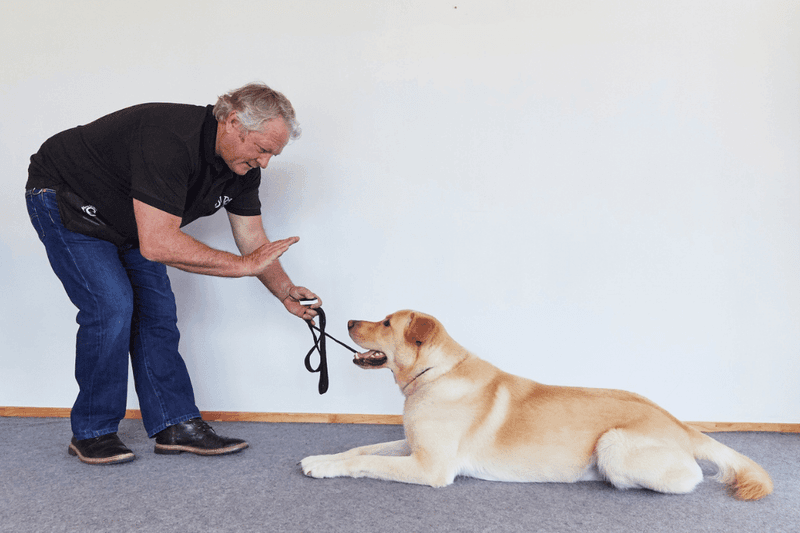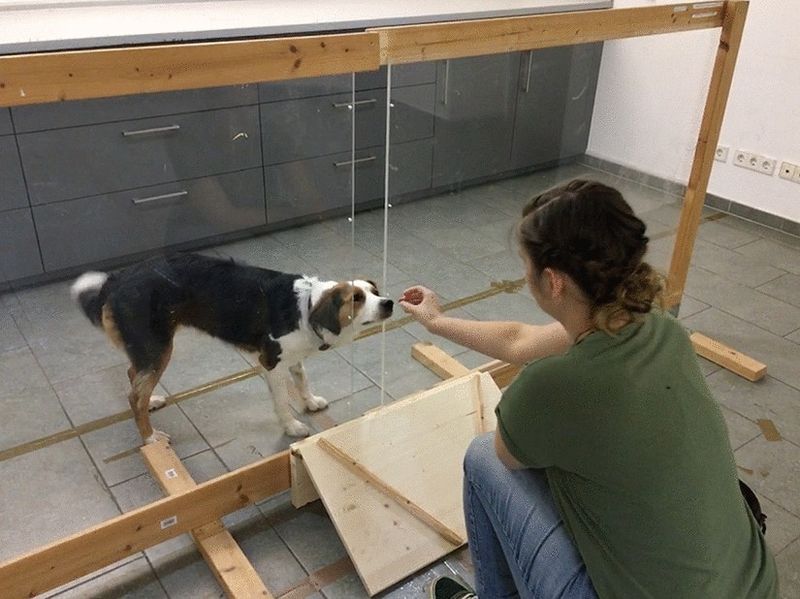Dogs are incredible companions, known for their intelligence and ability to communicate with humans. However, there are certain words they understand and others they struggle with. This article explores these words, highlighting the nuances in canine comprehension, which often surprise even the most devoted dog owners. From commands that dogs grasp effortlessly to those that puzzle them, this exploration is both amusing and enlightening. Let’s delve into the world of canine linguistics, providing a fascinating glimpse into the minds of our four-legged friends.
Understand: Sit
Dogs, especially breeds like the Golden Retriever, quickly grasp the command “sit”. This straightforward word often marks the beginning of a dog’s training journey. With consistency and patience, many dogs learn to associate “sit” with the action of lowering their hindquarters to the ground. This command is not just foundational but also essential, helping in various situations, from waiting at street crossings to remaining calm at home. Seeing a dog respond to “sit” brings joy to any pet owner, reflecting mutual understanding.
Struggle: Hypotenuse
Mathematical and abstract terms like “hypotenuse” tend to baffle even the smartest dogs. Unlike commands like “sit” or “stay”, words involving mathematical concepts don’t relate to actions or objects in a dog’s world. The Border Collie, known for its intelligence, might give you a quizzical look if you toss around such terms. Dogs excel in understanding tone and context, not abstract reasoning. Thus, complex vocabulary leaves them puzzled, as it’s outside their realm of experience and training.
Understand: Come
The command “come” is integral to ensuring a dog’s safety and reinforcing the bond with its owner. A Labrador Retriever, with its eager-to-please nature, often responds swiftly to this command. Training a dog to “come” is vital, providing them freedom to explore while ensuring they return when needed. This command is best practiced in safe, open areas where a dog can freely run back to its owner. Responsive dogs that understand “come” reflect trust and a strong relationship with their human companions.
Struggle: Quantum
Quantum physics is a challenging subject even for humans, so it’s no surprise that terms like “quantum” are beyond a dog’s comprehension. Dogs are attuned to familiar sounds and commands, rather than abstract scientific concepts. Even a curious dachshund, known for its inquisitive nature, would be flummoxed by such complex terminology. Their world revolves around tangible experiences, sounds, and commands linked to emotions or actions. Thus, abstract scientific terms remain as elusive to them as a faraway galaxy.
Understand: Stay
The command “stay” is indispensable for a dog’s safety and obedience training. Known for their discipline, German Shepherds excel in mastering this command. The ability to “stay” ensures the dog remains in place, even amidst distractions. Mastering “stay” requires patience, gradual increase in duration and distance, and positive reinforcement. This command is crucial, whether it’s to prevent a dog from bolting onto a busy street or to keep them steady while guests arrive. A trained dog aptly responding to “stay” embodies discipline and safety.
Struggle: Existential
The concept of “existential” delves into human philosophy, making it perplexing for dogs. While poodles, with their high intelligence, are adept at learning various commands, abstract philosophical terms elude them. They excel in understanding direct commands associated with physical actions or rewards. Words like “existential” don’t resonate with them, as their world is more about sensory experiences. Dogs rely on direct communication and tone, rather than grappling with introspective human concepts. This makes abstract words, such as these, outside their grasp.
Understand: Fetch
“Fetch” is more than just a game; it’s an activity that taps into a dog’s instinctual desire to retrieve. Border Collies, with their boundless energy and intelligence, excel at this command. When a dog is told “fetch”, it’s an invitation to engage in play and exercise, strengthening the bond with its owner. The command is not only fun but also mentally stimulating, allowing dogs to channel their energy positively. Playing fetch cultivates a dog’s focus, agility, and ability to follow instructions.
Struggle: Ephemeral
Words like “ephemeral” are challenging for dogs, as they deal with abstract, fleeting concepts. A beagle, known for its curious and determined demeanor, would be puzzled by such terms. Dogs thrive on concrete commands that relate to immediate actions or rewards. Unlike humans, dogs don’t contemplate the transient nature of existence. For them, life is about the present moment and experiences tied to direct stimuli. Thus, abstract words like “ephemeral” fall outside their linguistic capabilities, leaving them bemused and uninterested.
Understand: Heel
“Heel” commands a dog to walk closely by their owner’s side, a crucial aspect of leash training. Dobermans, known for their loyalty and intelligence, often excel at heeling. Teaching “heel” requires patience and consistent practice, fostering discipline and reducing pulling during walks. This command is essential for urban environments where control is vital. A dog that masters “heel” showcases not only obedience but also a strong connection with its owner. Walking in tandem reflects harmony and mutual respect between dog and human.
Struggle: Metaphor
Metaphors, as figures of speech, pose a challenge for dogs, who interpret language literally. The charming French Bulldog might appear intrigued, yet words like “metaphor” escape their comprehension. Dogs excel in understanding tone, gestures, and direct commands rather than figurative language. Their world is tangible, relying on real-life interactions rather than abstract interpretations. While humans appreciate the nuances of language, dogs respond to clear, straightforward communication. Thus, metaphorical language remains a puzzle to them, far removed from their instinctual understanding.
Understand: Down
“Down” is a command that instructs a dog to lay down, promoting calmness and control. Bulldogs, with their laid-back temperament, often respond well to this command. Teaching “down” is essential for situations where a dog needs to relax or stay put. It requires patience and positive reinforcement, helping dogs associate the command with relaxation. The “down” command is vital for managing a dog’s behavior, ensuring they remain composed in various settings, from busy households to outdoor cafes. Mastery of “down” reflects a dog’s obedience and trust.
Struggle: Algorithm
Words like “algorithm” elicit confusion in dogs, as these refer to complex, abstract processes. Even an intelligent Pomeranian would struggle with such terms, as they fall outside a dog’s experiential world. Dogs excel in understanding consistent commands and actions rather than abstract sequences. Their communication thrives on direct interactions, tone, and context. Words related to technology and computation are beyond their grasp, as they align more with human innovation than canine cognition. Thus, technical jargon remains enigmatic to our furry friends.
Understand: Wait
“Wait” is a command that teaches patience, especially when a dog eagerly anticipates something rewarding. Cocker Spaniels, known for their gentle disposition, often excel at this. Training a dog to “wait” involves rewarding restraint and control, crucial in situations that require patience. From waiting for a meal to holding back before crossing a street, “wait” is invaluable. It ensures a dog learns to pause and assess, reflecting discipline and training success. A dog that masters “wait” displays trust and understanding with its owner.
Struggle: Paradox
Paradoxes, with their contradictory nature, are perplexing even to humans, making them incomprehensible to dogs. A lively Jack Russell Terrier might tilt its head in curiosity at the word, yet such concepts elude canine understanding. Dogs thrive on clear, direct communication, rather than grappling with complex linguistic puzzles. Their world is grounded in immediate experiences and straightforward commands. While humans ponder over paradoxes, dogs focus on tangible interactions. Thus, paradoxical language remains beyond their reach, nestled in the realm of human abstraction.
Understand: Leave It
“Leave it” is a command that instructs a dog to ignore or refrain from engaging with something tempting. Rottweilers, known for their obedience, often master this crucial command. “Leave it” is essential for ensuring a dog’s safety, preventing them from ingesting harmful substances or objects. Training this command requires consistency and positive reinforcement, helping dogs learn restraint and self-control. Mastery of “leave it” reflects a dog’s discipline and respect for their owner’s guidance, highlighting a bond built on training and trust.
Struggle: Ontology
Ontology, a complex philosophical concept, is far beyond a dog’s understanding. Even a thoughtful German Shepherd, renowned for its intelligence, would find such abstract notions puzzling. Dogs excel in comprehending straightforward commands linked to actions or rewards. Their world is defined by sensory experiences and direct communication, not abstract philosophical discourse. While humans explore deep philosophical questions, dogs engage with the world through more immediate, practical interactions. As such, ontological discussions remain inaccessible to our canine companions.
Understand: Roll Over
“Roll over” is a classic dog trick that showcases a pet’s playfulness and training. Beagles, with their playful nature, often delight in performing this trick. Teaching “roll over” involves patience and rewards, transforming it into a fun activity that strengthens the bond with the owner. This command provides mental stimulation and an opportunity for positive interaction. Dogs that master “roll over” not only entertain but also demonstrate their training and eagerness to please. It’s a joyful expression of a well-trained, happy dog.
Understand: Walk
With tails wagging and ears perked, the word “walk” is often music to a dog’s ears. Imagine the excitement that fills their eyes as soon as this simple word escapes your lips. For many, it’s the highlight of their day—a chance to explore, sniff, and stretch their legs.
Dogs have an innate love for adventure, and the mere mention of a walk invites visions of open fields and playful encounters. This enthusiasm isn’t just instinctual; it’s a bond-building exercise that strengthens the human-canine relationship.
A walk is more than exercise; it’s a joyful ritual.


















